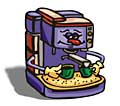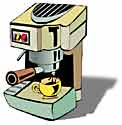|
|
Espresso: An Art Form with Its Own Following
by Marjorie Dorfman
|
 Espresso machines were driven by steam. The two problems, blowing up and burning the coffee were solved in 1935 by a man named Francesco Illy, who in 1935 invented the Illetta, (which bears the name of his wife’s relatives). It utilized air pressure to force the water into the grounds. This was more controllable than steam and with its elimination the coffee did not burn. The cylinder used could be made to precisely control the amount of water and the extraction was done automatically. Espresso machines were driven by steam. The two problems, blowing up and burning the coffee were solved in 1935 by a man named Francesco Illy, who in 1935 invented the Illetta, (which bears the name of his wife’s relatives). It utilized air pressure to force the water into the grounds. This was more controllable than steam and with its elimination the coffee did not burn. The cylinder used could be made to precisely control the amount of water and the extraction was done automatically.
In 1945 the system was simplified even further by the invention of the Gaggia coffee machine. This utilized lever action to force the water into the grind holder. In the 1970’s, Ernesto Illy further simplified the whole device by introducing the Espresso Coffee System which incorporated the best of the previous machines. It added two layers of filter paper, was cheaper and, according to those in the know, was easy enough for even the village idiot and his entourage to operate. One of the last adaptations came in 1950 by Ernest Valente who introduced the rotating pump driven by an electric motor. This developed the water pressure and allowed for a more continuous delivery of the water. An additional development was a rotating coffee grind delivery system which made the process almost totally automatic.
 Now back to that word expresso. You may recall that I said earlier that the word can mean fast or straight through. (Of course you do.) Well, it can also mean to squeeze out by pressure or to elicit by force. A third meaning is to be explicit; such as the express purpose of her visit. All of the definitions can be adapted to the way the machine works. First it squeezes out the juice (grinds). Then it does so in a fast way. And, it squeezes out the juice in a rapid manner for the explicit purpose of making a single cup of coffee. How do you like them there apples?
Now back to that word expresso. You may recall that I said earlier that the word can mean fast or straight through. (Of course you do.) Well, it can also mean to squeeze out by pressure or to elicit by force. A third meaning is to be explicit; such as the express purpose of her visit. All of the definitions can be adapted to the way the machine works. First it squeezes out the juice (grinds). Then it does so in a fast way. And, it squeezes out the juice in a rapid manner for the explicit purpose of making a single cup of coffee. How do you like them there apples?
A secondary factor in the making of a perfect espresso is the way the milk is utilized. Mousse was the original term given to the presentation, but later it turned to froth. (The word, not the milk.) There are two types of mousse; one is a short floating milk cover and the other is a milk cover mixed into the coffee. Mousse adds both a smoother taste and minimizes heat loss with its exact blend of carbon dioxide bubbles and milk. The color of the mousse should be that of a milk chocolate bar. If it is too dark, this indicates over-extraction and if it’s too light, there hasn’t been enough.
And so my friends, we have from Rome arrived. The issue of which came first, the chicken or the egg may never be resolved, but I suppose one can surmise a sort of chronology as far as espresso is concerned. First came just coffee and plain hot water. Then came an espresso maker, which forced steam through the coffee grinds. Then came the expresso pneumatic press. If you are still confused, you are not alone. The mystery may never be unraveled and the plot thickens and the story changes from country to country, book to book and person to person. But it matters not. Whether or not the truth will set us free can be argued on many platforms, but no one can deny that a cup of espresso or expresso will wake one up and open one’s eyes anytime!
Did you know . . .
|
|
|
|
 |
Delicious gourmet cookie gifts and cookie tins that you can personalize!
 
Click Here for more information.
Check these reviews by Marjorie of interesting kitchen gadgets:
Give me your tired, your poor, your caffeinated.
A Great Coffee Maker
When you simply can’t wait a moment more for that caffeine fix!
The Electric Kettle
|
 "Our lives are not in the lap of the gods, but in the lap of our cooks." "Our lives are not in the lap of the gods, but in the lap of our cooks."
Lin Yutang
The Importance of Living, 1937
"Talk of Joy: there may be things better than beef stew and baked potatoes and home-made bread
. . . there may be."
David Grayson
Adventures in Contentment, 1907
|

Click for a printer friendly version of this article.
|
|